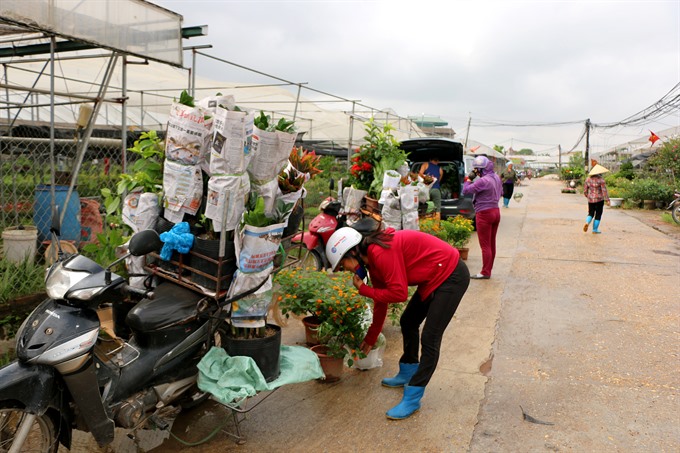 |
| Attraction: More and more people are visiting Xuan Quan for its high-quality flowers. VNS Photo Doan Tung |
Viet Nam News
Switching from rice and maize to growing flowers and applying high-tech methods has helped Xuan Quan Commune earn VND200 billion (US$8.7 million) each year. Bui Quynh Hoa reports.
The rainy season has hit the north of the country causing the sky to turn black in almost an instant. Everywhere you go, people are talking about thunderstorms, floods, tree falling, landslides and the number of fatalities.
We left Ha Noi on a working trip to Xuan Quan Commune, a young flower hub in Hung Yen Province’s Van Giang District, but as the clouds moved in, we were worried that we wouldn’t get the chance to get outside to interview locals, take photographs and shoot a video. But wow, God blessed us. When we got there, beautiful flowers in an array of vibrant colours greeted us in sunshine. Rows of small houses nestled amongst flower and ornamental plant gardens in full bloom were a sight we dared not dream of as we left the capital.
Grow flowers, earn a fortune
Xuan Quan has been transformed from a land of rice and maize cultivation in recent years to a rich area which could supply flowers and ornamental plants to clients in many major cities throughout the country.
According to Le Quy Don, chief of Xuan Quan Commune, local people have made full use of every inch of land to grow flowers, as farm land narrows due to urbanisation.
Some have even become millionaires thanks to the move.
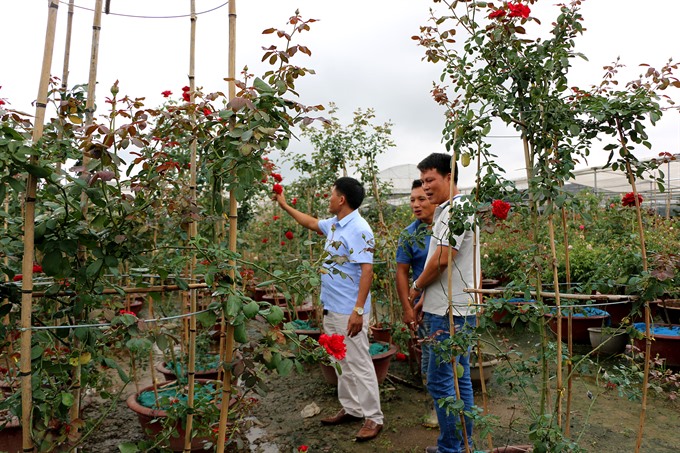 |
| Profits: Chairman of Xuan Quan Village, Le Quy Don (first left) says the average yield from flower growing makes a profit of VND1-1.5 billion ($43,000-64,400) per hectare per year. VNS Photo Doan Tung |
“At present, the village has about 170 hectares of arable land used for growing flowers and ornamental plants with roses, chrysanthemums, dahlias, lilies, and orchids, to name but a few, along with trees for gardens and interior decor. A total of 872 households are involved in the flower industry, accounting for more than a third of the population,” Don said.
“The whole commune makes an estimated VND200 billion (US$8.7 million) per year, with each household making a profit of VND300 million ($12,800) to VND3 billion ($1.28 million) per year. The work has created jobs for more than 1,000 workers in the commune and other regions with an average income of VND4.5-6 million ($193-258) per month,” he said.
Unlike farmers in other flower communes like Tay Tuu (Bac Tu Liem District) and Me Linh (Vinh Phuc Province) who sell cut flowers on the first and 15th day of the lunar month and festive holidays, Xuan Quan’s farmers have found their own way to meet the demand by selling flower plants, hanging baskets, bonsai trees, and trees for garden and interior decor all year round.
“We’re proud to say that Xuan Quan has all kinds of flowers and ornamental plants which are sold in the local market,” said Nguyen Van Thom, the owner of a 5,000sq.m flower garden who makes an average profit of VND2.5 billion ($107,500) a year. “Xuan Quan has about 200 species of roses alone," he added.
“Our flowers are of high quality with long-time guarantees, and prices are also comparative, from VND5,000 per sapling to hundreds of millions dong for a bonsai tree. That’s why more and more clients are coming to us,” Thom said.
Nguyen Van Tuyen, 36, who imported roses and forest orchids to grow on an area of 7,000sq.m, said the supply from Xuan Quan still could not meet the market demand last year.
“We are happy to have earned trust and built a reputation for our products. The more flowers we sell, the more our lives are improved,” Tuyen said with a broad smile.
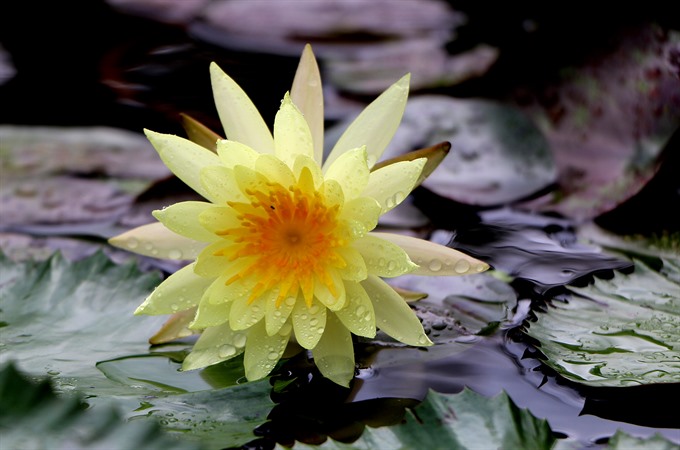 |
 |
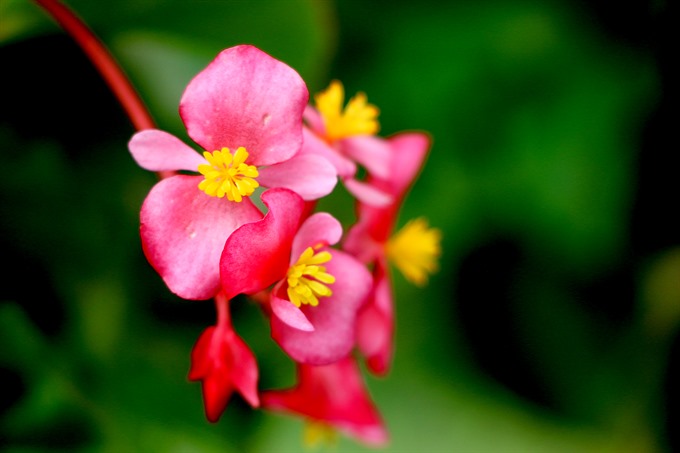 |
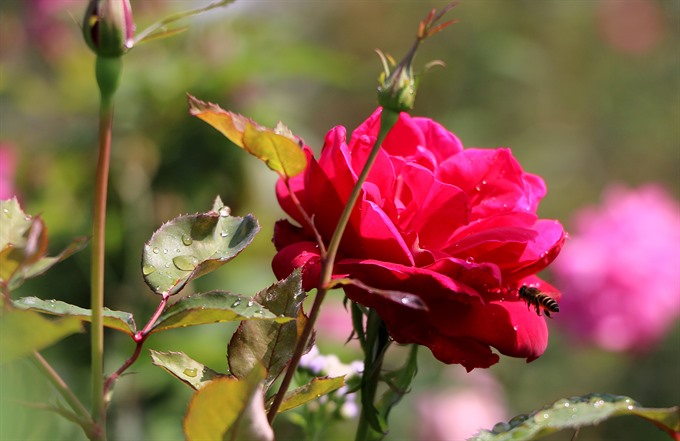 |
| Spectacular: Flowers booming in Xuan Quan Village. VNS Photo Doan Tung |
|
High-tech application
Nguyen Minh Duc, 40, the owner of a 1,000sq.m garden, is also a leading farmer in the commune who has studied in China, Thailand, the Philippines and other neighbouring countries to learn more about their techniques and to buy their new “mother” plants.
“I have also invested a lot of money in building nets, greenhouses, frames and modern equipment,” Duc said.
These help the flowers grow well and earn him a profit of VND2 billion ($85,900) per year.
Leaving Duc’s garden, we visited Phan Ngoc Oanh, one of the first flower farmers in the village.
“I started my business in 1989. I loved flowers so much that I decided to switch from food crops to flowers,” Oanh said. “Many people thought I was crazy at the time, but I didn’t care. I was happy to devote myself to it.”
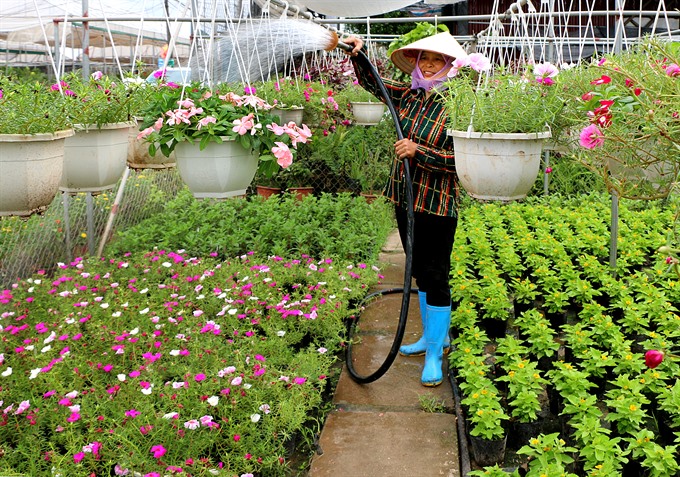 |
| Thirsty work: Flowers being watered. VNS Photo Doan Tung |
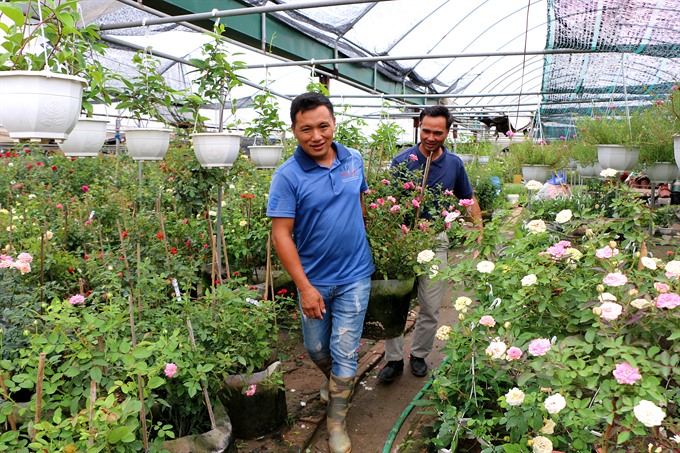 |
| Rose garden: Nguyen Minh Duc (front) and Nguyen Van Thom pick roses to show their clients . VNS Photo Doan Tung |
 |
| Innovation: Farmer Phan Ngoc Oanh checks his saplings raised using asexual multiplication. VNS Photo Doan Tung |
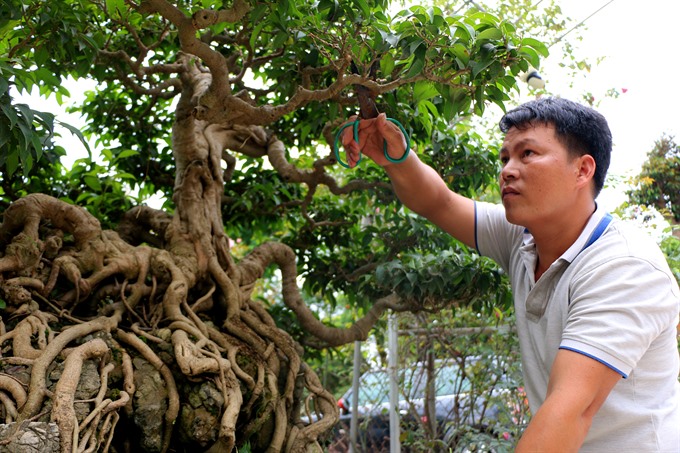 |
| Money doesn’t grow on trees: Nguyen Van Tuyen with a bonsai tree which costs VND130 million ($5,600). VNS Photo Doan Tung |
Oanh took part in training courses held by the commune in collaboration with the Viet Nam Agriculture Institute and the provincial Development Centre for Flowers and Ornamental Plants. He also flew to other countries frequently to learn new techniques.
In 2016, he decided to focus on high-tech genetic engineering.
“I have invested billions of dong to build four genetic engineering labs with advanced equipment, and invited two Thai experts to work at my labs for six months to experiment with genetic engineering,” Oanh said.
Genetic engineering is an asexual multiplication method which provides perfect efficiency for flower growing. Applying the technique, Oanh has about 20,000 orchid saplings, 500,000 gerbera saplings and 5,000 cymbidium saplings.
“The whole commune has to pay an estimated VND100 billion ($4.3 million) each year to buy “mother” flower plants from other countries,” he said.
“If my experimentation with genetic engineering is a success, the local farmers won’t have to buy expensive plants from abroad any more.
“My dream is to become a sapling supplier for not only Xuan Quan and other flower villages across the country, but also foreign markets which we used to import from.
“Furthermore, the Earth is becoming hotter and hotter, so investment in green trees is needed to protect our environment,” Oanh said.
Ecotourism blooming
Located adjacent to Ha Noi, Ecopark Green City and Bat Trang Pottery Village, Xuan Quan is an ideal spot to attract more visitors.
Nowadays, thousands of visitors head to the commune to buy flowers, bonsai and other ornamental plants, and to take photographs and videos.
Last year, the commune held a flower festival for the first time involving around 700 households.
“Facing this rapid development, Xuan Quan has drawn up measures to tap its full potential and strengths to develop flowers and ornamental plants and improve economic efficiency,” commune chief Don said.
“We are also asking agencies to help with building wholesale markets and invest in infrastructure such as roads and irrigation works so we can promote our flowers and bonsai more effectively,” he added. VNS
OVietnam